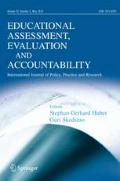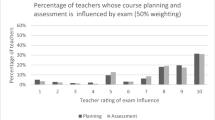Abstract
There is now a well developed literature on the impact of high stakes testing on teaching approaches and student outcomes. However, the student perspective has been neglected in much research. This article draws on a mixed method longitudinal study of secondary students in the Republic of Ireland to explore the impact of two sets of high stakes examinations on student experiences. The analyses are based on surveys completed by 897 lower secondary students and 748 upper secondary students, along with 47 lower secondary and 53 upper secondary group interviews with students. Findings show the presence of impending high stakes exams results in increased workload for students, with many reporting pressure and stress. Throughout their schooling career, students clearly favour active learning approaches. However, for some students, particularly high-aspiring middle-class students, these views change as they approach the terminal high stakes exam, with many showing a strong preference for a more narrowly focussed approach to exam preparation. This article highlights how students shift from a position of critiquing exam-focused teaching methods as inauthentic to accepting such methods as representing ‘good teaching’.





Similar content being viewed by others
Notes
This is not to imply that social reproduction does not occur when other forms of assessment are used. A large body of research points to the way in which middle-class families seek to promote the educational attainment of their children through a diverse range of strategies, including selecting particular types of schools, curricular programmes and/or subject areas which are seen as prestigious (see, for example, Lucas 2001 on ‘effectively maintained inequality’).
References
Abrams, L. M., Pedulla, J. J., & Madaus, G. F. (2003). Views from the classroom: teachers’ opinions of Statewide testing programs. Theory Into Practice, 42(1), 18–29.
Airasian, P. W., & Madaus, G. F. (1983). Linking testing and instruction: policy issues. Journal of Educational Measurement, 20, 103–118.
Au, W. (2007). High-stakes testing and curricular control. Educational Researcher, 36, 258–267.
Au, W. (2008). Devising inequality: a Bernsteinian analysis of high-stakes testing and social reproduction in education. British Journal of Sociology of Education, 29(6), 639–651.
Au, W. (2010). The idiocy of policy: the anti-democratic curriculum of high-stakes testing. Critical Education, 1, 1–15.
Bazely, P. (2007). Qualitative data analysis with NVivo. London: Sage Publications.
Bolhuis, S., & Voeten, M. J. M. (2001). Towards self-directed learning in secondary schools: what do teachers do? Teaching and Teacher Education, 17(7), 837–855.
Bourdieu, P. (1973). Cultural reproduction and social reproduction. In R. K. Brown (Ed.), Knowledge, education and cultural change. London: Tavistock.
Bourdieu, P. (1984). Distinction: A social critique of the judgement of taste. London: Routledge and Kegan Paul.
Bourdieu, P. (1986). The forms of capital. In J. G. Richardson (Ed.), Handbook of theory and research for the sociology of education. New York: Greenwood Press.
Bourdieu, P. (1990). In other words: Essays towards a reflexive sociology. Cambridge: Polity Press.
Bourdieu, P., & Passeron, J. C. (1977). Reproduction in education, society and culture. London: Sage.
Breen, R., Hannan, D. F., & O’Leary, R. (1995). Returns to education: taking account of employers’ perceptions and use of educational credentials. European Sociological Review, 11, 59–73.
Byrne, D., McCoy, S., & Watson, D. (2009). School Leavers’ Survey report 2007. Dublin: ESRI and Department of Education and Science.
Day, C., Sammons, P., Kington, A., Gu, Q., & Stobart, G. (2006). Methodological synergy in a national project: the VITAE story. Evaluation & Research in Education, 19(2), 102–125.
Diamond, J. B. (2007). Where the rubber meets the road: rethinking the connection between high-stakes testing policy and classroom instruction. Sociology of Education, 80, 285–313.
Ecclestone, K., & Pryor, J. (2003). Learning careers or assessment careers? The impact of assessment systems on learning. British Educational Research Journal, 29(4), 471–489.
EPPI. (2005). A systematic review of what pupils, aged 11–16, believe impacts on their motivation to learn in the classroom. London: EPPI Centre, University of London.
Eurydice. (2009). National testing of pupils in Europe: Objectives, organisation and use of results. Brussels: European Commission.
Galton, M., Morrison, I., & Pell, T. (2000). Transfer and transition in English schools: reviewing the evidence. International Journal of Educational Research, 33(4), 341–363.
Gilleece, L., Sheil, G., Perkins, R., & Proctor, M. (2009). Teaching and Learning International Survey (2008): National report for Ireland. Dublin: Educational Research Centre.
Goldthorpe, J. H. (2007). Cultural capital: some critical observations. Sociologica, 2, 1–23.
Gorard, S., & See, B. H. (2011). How can we enhance enjoyment of secondary school? The student view. British Educational Research Journal, 37(4), 671–690.
Gorard, S., & Taylor, C. (2004). Combining methods in educational and social research. Buckingham: Open University Press.
Gordon, S. P., & Reese, M. (1997). High-stakes testing: worth the price? Journal of School Leadership, 7, 345–368.
Grodsky, E., Warren, J. R., & Felts, E. (2008). Testing and social stratification in American education. Annual Review of Sociology, 34, 385–404.
Guba, E., & Lincoln, Y. (2005). Pragmatic controversies, contradictions, and emerging confluencies. In N. K. Denzin & Y. S. Lincoln (Eds.), Handbook of qualitative research (pp. 191–216). Thousand Oaks: Sage.
Hallinan, M.T. (2008). Teacher influences on students' attachment to school. Sociology of Education, 81(3), 271-283.
Hammersley, M. (1996). The relationship between qualitative and quantitative research: Paradigm loyalty versus methodological eclecticism. In J. T. E. Richardson (Ed.), Handbook of qualitative research methods for psychology and the social sciences (pp. 159–174). Leicester: British Psychological Society Books.
Hannan, D. F., & Shortall, S. (1991). The quality of their education. Dublin: ESRI.
Hannan, D., Raffe, D., Smyth, E. (1997). Cross-national research on school to work transitions: an analytic framework. In P. Werquin, R. Breen, J. Planas (eds.) Youth Transitions in Europe: Theories and Evidence, Proceedings of the Third ESF Workshop of the Network on Transitions in Youth. Marseille: Cereq.
Hodkinson, P., & Sparkes, A. C. (1997). Careership: a sociological theory of career decision making. British Journal of Sociology of Education, 18, 29–44.
Jenkins, R. (2002). Pierre Bourdieu. Abingdon: Routledge.
Johnston, J., & McClune, W. (2000). Pupil motivation and attitudes. Research paper for the effects of the selective system of secondary education in Northern Ireland report. Belfast: DENI.
Jones, M. G., Jones, B. D., Hardin, B., Chapman, L., Yarbrough, T., & Davis, M. (1999). The impact of high-stakes testing on teachers and students in North Carolina. Phi Delta Kappan, 81, 199–203.
Kirby, D., & Gardner, M. (2010). The schooling they need: voicing student perspectives on their fourth year in senior high school. Canadian Journal of Education, 33, 108–139.
Klein, S. P., Hamilton, L. S., McCaffrey, D. F., Stecher, B. M., Robyn, A., & Burroughs, D. (2000). Teaching practices and student achievement. Santa Monica: Rand.
Ladson-Billings, G. (2006). From the achievement gap to the education debt: understanding achievement in U.S. schools. Educational Researcher, 35(7), 3–12.
Lareau, A. (2003). Unequal childhoods. Berkeley: University of California Press.
Lucas, S. (2001). Effectively maintained inequality: education transitions, track mobility, and social background effects. The American Journal of Sociology, 106(6), 1642–1690.
Lumby, J. (2011). Enjoyment and learning. British Educational Research Journal, 37, 247–264.
Madaus, G. F. (1988). The distortion of teaching and testing: high-stakes testing and instruction. Peabody Journal of Education, 65, 29–46.
Madaus, G. F., & Greaney, V. (2005). The Irish experience of competency testing: implications for American education. American Journal of Education, 93, 268–294.
McCoy, S., Byrne, D., O’Connell, P. J., Kelly, E., & Doherty, C. (2010). Hidden disadvantage? A study of the low participation in higher education by the non manual group. Dublin: Higher Education Authority.
Meo, A.I. (2011). Zafar, so good: middle-class students, school habitus and secondary schooling in the City of Buenos Aires (Argentina). British Journal of Sociology of Education, 32(3), 349-367
Nichols, S. L., Glass, G. V., & Berliner, D. C. (2005). High-stakes testing and student achievement. Arizona: Arizona State University.
Noguera, P. A. (2007). How listening to students can help schools to improve. Theory Into Practice, 46, 205–211.
Osler, A. (2010). Students’ perspectives on schooling. Maidenhead: Open University Press.
Pollard, A., & Filer, A. (2007). Learning, differentiation and strategic action in secondary education. British Journal of Sociology of Education, 28(4), 441–458.
Putwain, D. W. (2009). Assessment and examination stress in Key Stage 4. British Educational Research Journal, 35, 391–411.
Ramussen, A., & Friche, N. (2011). Role of assessment in secondary education: participant perspectives. Educational Assessment, Evaluation and Accountability, 23, 113–129.
Reay, D. (2004). “It’s all becoming a habitus”: beyond the habitual use of Pierre Bourdieu’s concept of habitus in educational research. British Journal of Sociology of Education, 25(4), 431–444.
Reay, D., David, M. E., & Ball, S. (2005). Degrees of choice: Social class, race and gender in higher education. Stoke on Trent: Trentham Books.
Reay, D., Crozier, G., & Clayton, J. (2010). ‘Fitting in’ or ‘standing out’: working-class students in UK higher education. British Educational Research Journal, 36(1), 107–124.
Rutter, M., Maughan, B., Mortimore, P., Ouston, J., & Smith, A. (1979). Fifteen thousand hours: Secondary schools and their effects on children. London: Open Books.
Ryan, R., & Weinstein, N. (2009). Undermining quality teaching and learning: a self-determination perspective on high-stakes testing. Theory and Research in Education, 7, 224–233.
Shepard, L.A., & Dougherty, K.C. (1991). Effects of high stakes testing on instruction. Paper to AERA Annual Conference.
Smith, D. J., & Tomlinson, S. (1989). The school effect: A study of multi-racial comprehensives. London: Policy Studies Institute.
Smyth, E. (1999). Do schools differ? Academic and personal development among pupils in the second-level sector. Dublin: Oak Tree Press/ESRI.
Smyth, E., Calvert, E. (2011). Choices and challenges: moving from junior cycle to senior cycle education. Dublin: Liffey Press.
Smyth, E., Banks, J., Calvert, E. (2011). From Leaving Certificate to leaving school: a longitudinal study of sixth year students. Dublin: Liffey Press.
Smyth, E., McCoy, S., Darmody, M. (2004). Moving up: the experiences of first year students in post-primary education. Dublin: Liffey Press/ESRI.
Smyth, E., McCoy, S. (2009). Investing in education: combating educational disadvantage, Dublin: ESRI/Barnardos.
Smyth, E., Dunne, A., Darmody, M., McCoy, S. (2007). Gearing up for the exam? The experiences of Junior Certificate students. Dublin: Liffey Press/ESRI.
Stecher, B. M. (2002). Consequences of large-scale, high-stakes testing on school and classroom practice. Santa Monica: Rand.
Tashakorri, A., & Teddlie, C. (2003). Handbook of mixed methods in social and behavioral research. California: Sage.
Teddlie, C., & Stringfield, S. (1993). Schools make a difference: Lessons learned from a 10-year study of school effects. New York: Teachers College Press.
Thomson, R. (2011). Unfolding lives: Youth, gender and change. Bristol: Policy Press.
Triplett, C. F., & Barksdale, M. A. (2005). Third through sixth graders’ perceptions of high-stakes testing. Journal of Literacy Research, 37, 237–260.
Weiss, M. (2009). Student perceptions of high stakes testing. Saarbrücken: Verlag.
West, A. (2010). High stakes testing, accountability, incentives and consequences in English schools. Policy & Politics, 38, 23–39.
Wheelock, A., Bebell, D.J., & Haney, W. (2000). What can student drawings tell us about high-stakes testing in Massachusetts? Teachers College Record, published 2 November.
Willis, P. (1978). Learning to labour. Surrey: Ashgate.
Yair, G. (2000). Reforming motivation: how the structure of instruction affects students’ learning experiences. British Educational Research Journal, 26(2), 191–210.
Acknowledgments
The study on which this article is based was funded by the National Council for Curriculum and Assessment (NCCA) and the Department for Education and Skills. The authors are extremely grateful to Anne Looney and John Hammond of the NCCA for their support throughout the study. We would also like to thank participants at an AERA symposium, particularly the discussant, Jim Deegan, for their helpful comments on an earlier version of this article.
Author information
Authors and Affiliations
Corresponding author
Rights and permissions
About this article
Cite this article
Smyth, E., Banks, J. High stakes testing and student perspectives on teaching and learning in the Republic of Ireland. Educ Asse Eval Acc 24, 283–306 (2012). https://doi.org/10.1007/s11092-012-9154-6
Received:
Accepted:
Published:
Issue Date:
DOI: https://doi.org/10.1007/s11092-012-9154-6




